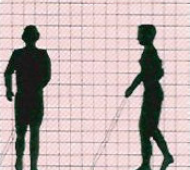Smartips

Sensory Disability and the Environment
Visual or hearing Impairment
- Visually or hearing impaired can be the result of accident or disease at any time and it is difficult to imagine what it is like to have to live with it.
- When it is congenital and the person has never experienced sight or hearing, it is impossible to imagine.
- Visually or hearing impaired brings difficulties in communication with other people which can lead to a desolate sense of isolation.
- When we get lost we can ask someone the way. If we are visually impaired, the message doesn’t come through. If we are hearing impaired, it doesn’t either.
- We can have compassion, but we can only achieve a limited understanding.
- Life becomes normal, meaningless and enjoyable by the support of an environment with proper assistive facilities.
Children with Sensory DisabilityChildren with Sensory Disability
- Children who are visually or hearing impaired have particular problems because education normally depends on seeing and hearing.
- Children who are with slight visually or hearing impaired can be satisfactorily integrated into normal schools given some special facilities and teaching aids.
- Children who are with serious visually or hearing impaired may require special equipment, specialist teachers and purpose designed environments of special schools.
- Children are resilient and resourceful in making the most of their capabilities even if these are reduced by disability.
Environmental Hazards & Solution for the Visually Impaired
- Persons with Visually Impairment (”PVIs”) need tactile and audible cues to compensate for the visual. What are some of these?
- Hard and resonant floors to provide some noise and echo.
- Floor surfaces should be non-slip with secure coverings.
- Floor finishes and textures to indicate approach to stairways.
- Unexpected projections above floor level are a hazard.
- The underside of stairs and ramps can also be hazardous.
- Ramps should have different surface texture from adjacent pavement.
- Doors should not open into circulation areas.
- Glass doors can be hazardous unless conspicuously marked.
- Raised letters and numbers on building signs for tactile recognition.
- Lifts should be fitted with visual and audible signals.
- Provide large, clear sign posting with adequate lighting.
- PVIs have some of the same needs as PMDs. Handrails should extend beyond the end of steps and ramps by at least 300mm.
- Provide contrasting colour handrails.
- PVIs demand extra care in normal safety measures. In the home, gas cookers have the advantage in that the gas supply can be heard and smelt. With electric cookers, the heat remaining after switching off can be a hazard. Electric Induction Cooker with Auto Switch-off will be more safe.
- Storage shelves with raised front edges are safer.
- Door knobs may be preferred to lever handles to avoid catching clothing. This problem can be avoided if lever handles turn in at the end.
- Sculpture with tactile qualities adds interest to public places.
- Appropriate environmental design, mobility and orientation training is essential to improve the PVIs’ ability to cope with daily living.
Environmental Hazards & Solution for the Hearing Impaired
- Persons with Hearing Impairment (”PHIs”) need visual cues to compensate for their lack of hearing.
- Signs, public notices need to be large, clear and well-lit.
- Flashing lights can take the place of sound on: fire alarms, door bells, telephones.
- For the persons with slight hearing impaired, amplifiers can be added to the door bell or telephone.
- Special sound proofing e.g. double glazed windows, or acoustic treatment may be needed to reduce (extraneous) unwanted sound.
- Noisy heating, ventilation or air conditioning systems can be disturbing.
- When sound must be heard, it is important that it is loud and clear.
- Auditoria and other public places may need electronic aids such as FM radio aids, induction loop systems etc.
- The environment can help. But hearing impaired people suffer from not having an obvious disability. They may provoke impatience and irritation in others rather than sympathy. As well as an improved physical environment, they need more understanding and thoughtful assistance.
◀ back
▲ Return to top






_content.jpg)


_content.jpg)











